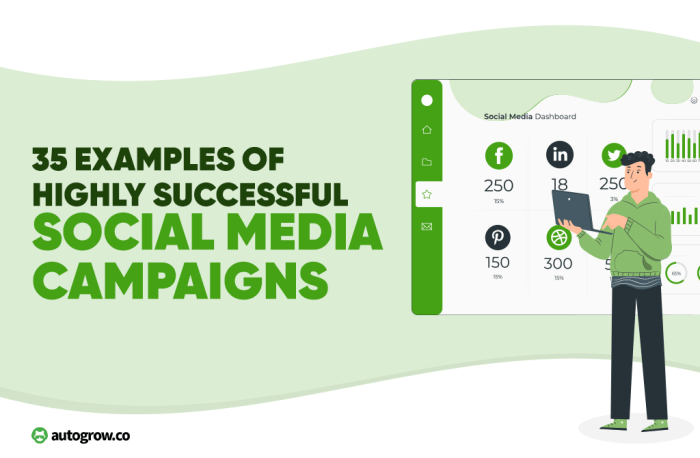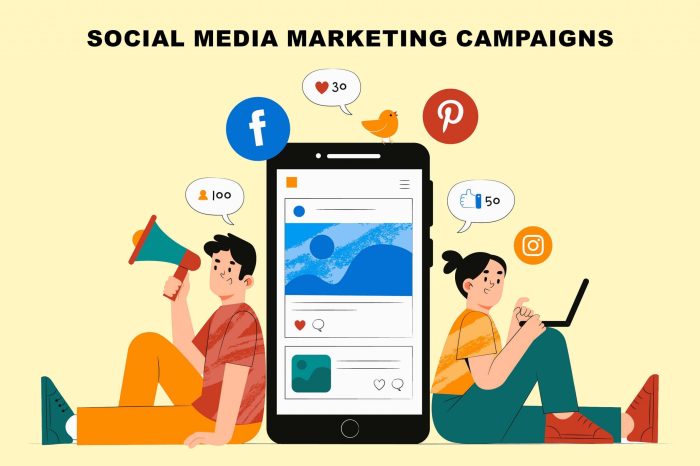Designing Social Media Campaigns: Get ready to dive into the world of creating impactful campaigns that resonate with your audience and drive results. From understanding the basics to mastering advanced strategies, this topic covers it all in a way that’s fresh and engaging.
Whether you’re a seasoned marketer or just starting out, there’s something here for everyone looking to elevate their social media game.
Understanding Social Media Campaigns
Social media campaigns are strategic marketing efforts designed to promote a specific goal or objective using social media platforms. The purpose of these campaigns is to increase brand awareness, engage with target audiences, drive website traffic, and ultimately boost conversions and sales.Designing effective social media campaigns is crucial for businesses and brands to stay relevant in today’s digital landscape. With the rise of social media usage, companies need to create campaigns that resonate with their target audience, stand out from competitors, and ultimately drive results.
A well-designed campaign can help businesses achieve their marketing goals and connect with customers in a meaningful way.
Examples of Successful Social Media Campaigns
- Old Spice: The “Smell Like a Man, Man” campaign featuring humorous videos went viral, increasing brand awareness and sales.
- Oreo: The “Dunk in the Dark” real-time marketing campaign during the Super Bowl blackout garnered significant social media buzz and engagement.
- ALS Ice Bucket Challenge: This campaign raised awareness and funds for ALS research through user-generated content shared across social media platforms.
Identifying Target Audience
Identifying the target audience is crucial for the success of a social media campaign as it helps in tailoring the content and messaging to reach the right people who are most likely to engage with the campaign.
The Significance of Identifying Target Audience
- Targeting the right audience increases the chances of conversion and engagement.
- Understanding the demographics, interests, and behaviors of the audience helps in creating relevant content.
- It saves time and resources by focusing on the most receptive audience.
Conducting Audience Research
- Use analytics tools to gather data on demographics such as age, gender, location, and income.
- Engage with the audience through surveys, polls, and feedback to understand their interests and preferences.
- Monitor social media interactions and behaviors to identify patterns and trends.
Segmenting the Target Audience
- Segment based on demographics like age, gender, location, occupation, and income level.
- Consider psychographics such as interests, values, attitudes, and lifestyle choices.
- Behavioral segmentation involves grouping based on purchase history, online activities, and engagement with the brand.
Setting Campaign Objectives
Setting specific, measurable, achievable, relevant, and time-bound (SMART) objectives is crucial for the success of a social media campaign. These objectives provide a clear roadmap for the campaign and help in measuring its effectiveness.
Examples of Common Social Media Campaign Objectives
- Increase brand awareness by reaching a specific number of followers or engagement metrics.
- Drive website traffic by increasing clicks on social media posts leading to the website.
- Generate leads by encouraging users to sign up for a newsletter or submit contact information.
Aligning Campaign Objectives with Marketing Goals
When setting campaign objectives, it is essential to ensure that they align with the overall marketing goals of the business. For example, if the marketing goal is to increase sales by a certain percentage, the social media campaign objectives should focus on driving conversions and sales through social channels. By aligning these objectives, the campaign becomes a strategic tool in achieving the broader marketing goals of the organization.
Content Strategy

In the world of social media campaigns, having a solid content strategy is key to success. It helps in creating a roadmap for your content creation, ensuring that your messaging is consistent, engaging, and aligned with your campaign objectives.
Creating Engaging and Shareable Content
Creating content that resonates with your target audience and encourages them to share it is crucial for the success of your social media campaigns. Here are some tips to help you create engaging and shareable content for different social media platforms:
- Understand your audience: Take the time to research and understand your target audience’s preferences, interests, and pain points. Tailor your content to meet their needs and address their concerns.
- Use visuals: Visual content such as images, videos, and infographics tend to perform better on social media. Incorporate eye-catching visuals into your content to grab the audience’s attention.
- Create compelling headlines: Craft attention-grabbing headlines that entice users to click and engage with your content. Keep them short, clear, and to the point.
- Encourage interaction: Prompt your audience to like, comment, share, and tag their friends in your posts. Engage with your followers by responding to comments and messages promptly.
- Stay on-trend: Keep up with the latest trends and topics in your industry and incorporate them into your content strategy. This shows that your brand is current and relevant.
Maintaining Consistency in Messaging and Branding
Consistency is key when it comes to maintaining your brand’s identity and messaging across different content types and social media platforms. Here are some tips to ensure consistency in your social media campaigns:
- Develop brand guidelines: Create a set of brand guidelines that Artikel your brand’s voice, tone, colors, and visual elements. Ensure that all content aligns with these guidelines.
- Use templates: Create templates for your social media posts to maintain a consistent look and feel across all platforms. This helps in reinforcing your brand’s identity.
- Coordinate content calendar: Plan your content in advance and create a content calendar to ensure that your messaging is cohesive and aligned with your campaign objectives.
- Monitor performance: Regularly analyze the performance of your content to see what resonates with your audience. Use this data to refine your content strategy and make improvements.
- Engage with your audience: Be responsive to comments, messages, and feedback from your followers. Building relationships with your audience helps in establishing trust and loyalty towards your brand.
Platform Selection: Designing Social Media Campaigns
When selecting the right social media platforms for a campaign, it’s essential to consider the target audience demographics, campaign objectives, budget, and the type of content you plan to share. Each platform has its strengths and weaknesses, so it’s crucial to choose wisely to maximize reach and engagement.
Comparison of Social Media Platforms, Designing Social Media Campaigns
- Facebook: Ideal for reaching a wide audience and building brand awareness through targeted advertising and engaging content.
- Instagram: Great for visual content and reaching a younger demographic, especially for lifestyle and fashion brands.
- Twitter: Best for real-time updates, news, and engaging in conversations with followers. Hashtags are essential for visibility.
- LinkedIn: Perfect for B2B campaigns, professional networking, and sharing industry-related content.
- TikTok: Popular among Gen Z and Millennials, suitable for creative and entertaining campaigns but requires a unique approach.
Factors to Consider in Platform Selection
- Demographics: Understand where your target audience spends their time online.
- Campaign Objectives: Choose platforms that align with your goals, whether it’s brand awareness, lead generation, or community building.
- Budget: Consider the cost of advertising on different platforms and choose one that fits your budget.
- Content Type: Select platforms that support the type of content you plan to create, whether it’s images, videos, or text-based posts.
Examples of Successful Campaigns
- Wendy’s on Twitter: Wendy’s witty and humorous responses to followers helped them gain a massive following and increased engagement.
- Dove’s Real Beauty Campaign on Instagram: Dove’s empowering and inclusive content resonated with their audience, leading to high engagement and positive brand sentiment.
- Red Bull on Facebook: Red Bull’s action-packed videos and extreme sports content attracted a large audience and boosted brand loyalty.
Budgeting and Resource Allocation

Budgeting for a social media campaign involves allocating funds for various aspects like paid advertising, content creation, and other expenses to ensure the campaign’s success. Effective resource allocation is crucial to maximize the performance of the campaign and achieve the desired objectives. Here are some tips for optimizing budget allocation based on campaign goals and target audience.
Importance of Budgeting
- Setting a clear budget helps in planning and executing the campaign efficiently.
- Allocating funds to different areas like paid ads, influencer partnerships, and content creation ensures a well-rounded approach.
- Monitoring and adjusting the budget based on performance metrics can lead to better ROI.
Tips for Optimizing Budget Allocation
- Identify campaign objectives and allocate a larger portion of the budget to areas that directly contribute to these goals.
- Research the target audience to understand their preferences and allocate resources to platforms where they are most active.
- Experiment with different budget allocations to find the optimal mix that drives engagement and conversions.
- Consider the seasonality of your business and adjust budget allocation accordingly to capitalize on peak times.
- Track the performance of each allocation to determine the most effective strategies and reallocate resources as needed.
Monitoring and Metrics
Monitoring key performance indicators (KPIs) during a social media campaign is crucial to understanding the effectiveness of your efforts. By tracking metrics, you can assess the impact of your campaign, identify areas for improvement, and make data-driven decisions to optimize performance.
Types of Metrics to Track
- Engagement: Measure likes, comments, shares, and overall interaction with your content to gauge audience interest and participation.
- Reach: Evaluate the number of people who have seen your posts to understand the extent of your campaign’s visibility.
- Conversions: Track the number of users who have taken a desired action, such as signing up for a newsletter or making a purchase, to assess campaign effectiveness.
- ROI (Return on Investment): Calculate the return on investment to determine the profitability of your social media campaign.
Monitoring Tools and Techniques
- Analytics Platforms: Utilize tools like Google Analytics, Facebook Insights, or Hootsuite to track and analyze key metrics in real-time.
- Social Listening: Monitor conversations, mentions, and sentiment around your brand using social listening tools to gain valuable insights for campaign optimization.
- A/B Testing: Experiment with different content variations to see which performs better and adjust your strategy accordingly for improved results.
- Reporting: Generate regular reports to review campaign performance, identify trends, and make informed decisions for future social media initiatives.